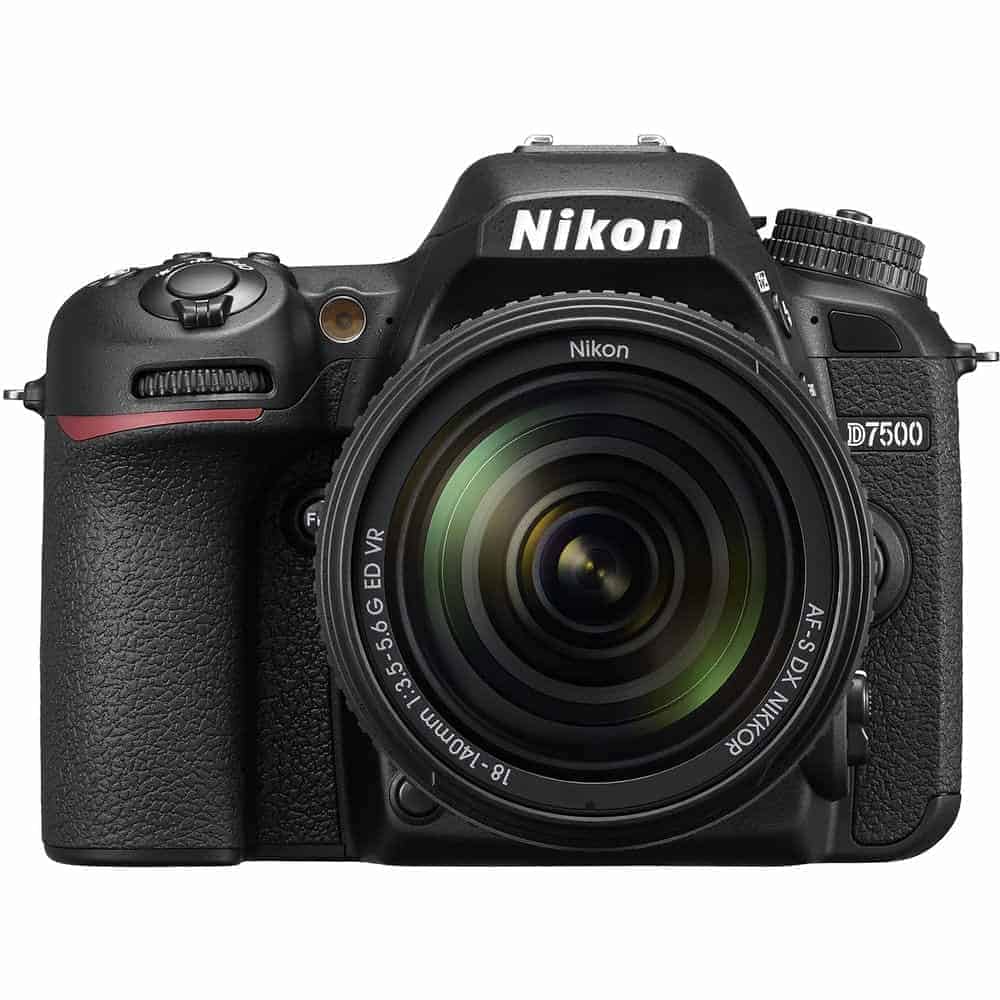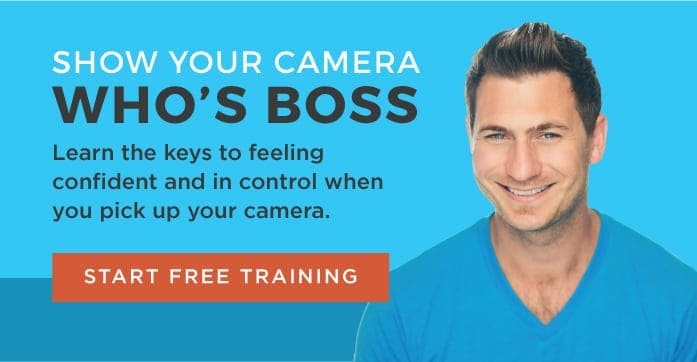- Total2
- Facebook0
- Pinterest0
- Email2
Review of the Nikon D7500

Nikon packed this DSLR system with 20.9 megapixels, an APS-C format sensor, and high-speed continuous shooting modes (at 8 frames per second). The D7500 is a comfortable camera for any photographer with its lightweight body, high ISO capabilities, a tilt screen touch LCD, and the ability to record in 4k.
While it may seem like this mid-tier camera is a step back from its previous predecessor, the D7200, this system is far more than what it seems.
Overview
Ease of Use:
The D7500 looks and feels much like the other Nikon D7000 series cameras yet it weighs 6 ounces less than its predecessor. If you’re out shooting all day, this slight decrease in weight is welcome. The D7500 has an easy to access menu and option controls, deep-set grip, and tilting LCD screen, making the camera comfortable and easy to use.
Many believe that this camera is ideal for the landscape or nature enthusiast given that it can shoot at 8 frames per second – perfect for capturing wildlife. The expanded ISO capabilities of the D7500 are tremendous in low-light situations, too. The built-in WiFi and Bluetooth systems makes the D7500 a great camera for all photographers.
With its menu buttons and controls set up so it’s easy to set up, the D7500 allows the photographer full control while also giving some flexibility while out in the field shooting. The locking feature on the mode dial also helps keep accidental switches from happening, which is something Nikon aimed to fix with this model.
Even those upgrading from the entry-level models like the Nikon D3400 will find it easy to transition to this camera.

Product Features:
- 20.9MP APS-C CMOS Sensor
- 51-point phase-detect AF
- 8 fps burst for 100+ JPEGS or 50 Raws
- 180k-pixel RGB sensor for metering and subject recognition
- Deeper grip
- 4K (UHD) video from 1.5x crop of the sensor
- Wi-Fi and Bluetooth
- 3.2" tilting touchscreen LCD
- In-camera batch Raw processing
- Weather Sealing
In-Depth Analysis
The D7500 may not have the dual SD card slots of the earlier D7200, but its durable body features improved weather sealing. Made from a carbon fiber frame, it’s a much lighter camera body compared to the earlier model. There isn’t an optional vertical grip available so for some photographers who primarily shoot vertical, or portraits might find this a drawback to the Nikon D7500.
The camera is fully customizable with 8 physical control points accessible via a ‘My Menu’ feature. This allows you to add settings to enhance faster shooting on location. In addition, the camera includes a microphone and headphone jack, USB and HDMI Type C and remote trigger/accessory terminals. These features are especially handy for shooting video.
The 3.2 tilting touch-screen LCD on the back of the camera is new to the D7500. Featuring touch focus, touch shutter, full touch to access menus and playback options, including scrolling and pinch to zoom, is responsive and makes shooting on location much simpler. You have everything you need to operate your camera at your fingertips.
Some might argue that the resolution of the LCD screen makes for a slight setback, however, it works quickly and is responsive. However, the Nikon D7500’s touch screen is not as responsive as the touch LCD on Canon models.. Complete with its pop-up flash and a hot shoe for external flashes, the Nikon D7500 gives you more range when you use the compatible SB-5000 Speedlight. Although the Nikon D7500 has fewer megapixels than its predecessor, at 21 megapixels the camera delivers great image quality characteristic of Nikon cameras. For anyone at the enthusiast level, this is perfectly fine. In low-light especially, this camera retains high levels of detail even at ISO 3200. ISO setting any higher than this may cause noise, but that is true for most cameras. The D7500 has great dynamic range and equally great RAW files that are easy to retouch in post-production.
The D7500 has a 51-point AF, 15 cross-type AF point system to offer better precision and accuracy in focusing. For wildlife and action photographers, this makes the D7500 an excellent choice with its enhanced subject detection and tracking, improving focus and isolating subjects.
The battery life is also a plus for the D7500, giving you an average of 950 shots per charge. However, some photographers get up to 1200 shots per charge with this camera. Not enough for a wedding, but it should last you through most long shooting days. With no external battery grip available, it’s best to pick up an extra battery just in case.
Although the camera offers 4K video recording, the consensus is that the video capabilities aren’t for those who primarily shoot video but are good enough for casual video users. The continuous AF just isn’t as smooth as expected. Add in the crop sensor, and you’ll definitely need a wide lens for recording wider shots in video.
The D7500 uses the same Wi-Fi/Bluetooth SnapBridge technology as other Nikon DSLRs, such as the D3400.

Who should shoot with the Nikon D7500?
Paired with the right lenses, this camera is perfect for all situations that an amateur photographer needs to level up from entry-level camera systems. The D7500 is aimed at someone who needs more than the standard features isn’t ready to pay the price for a professional camera just yet.
The camera also features fast 4K resolution at 30p, 25p, and 24p offering decent capture for videos. Overall, the camera is much better for stills than video. For the more experienced video shooter, there are better cameras. From landscape to wildlife, still life to portraits, this is a great camera at an excellent price point.

Common Complaints
- 4K video taken from a small crop of the sensor, limiting lens choice
- SnapBridge wireless system is simplistic and inconsistent
- Video tools are limited, no focus peaking
- Autofocus in video prone to wobble and hunting
- Default JPEG noise reduction and sharpening a little high
- Lack of an Ai indexing tab limits metering compatibility with old lenses
- One card slot (compared to its predecessor’s two slots)
- No ‘Touchpad AF’ when your eye is to finder
- No vertical accessory grip available
Common Accolades
- Excellent image quality: high quality Raw and JPEG
- Reliable autofocus performance, even at 8 fps
- Well-designed ergonomics and handling
- 4K video quality is generally strong
- Touchscreen implementation fast and effective
- Automated AF Fine Tune is very useful
- Impressively deep buffer
Product & Pricing Options
Final Words
The D7500 is a great, compact, crop sensor, lightweight camera with fast-tracking capabilities, excellent image quality, and perfect for those who are looking to shoot landscape, wildlife, or action photography.
The D7500 body can stand up to extreme weather and handles nicely with a deeper set grip and feel-good buttons and controls.
The Nikon D7500 is comparable to the D7200 however, with a dip in megapixels at only 21 versus the 24 megapixels of its predecessor, the image quality is still characteristic of Nikon’s superb high-quality and output especially in low-light situations.
With other features like the tilting touch LCD screen, locking dial, ISO range, comfortable menu button layout, and price range, the Nikon D7500 a solid investment for any enthusiast, if you’re okay with only one SD card slot.
All-in-all, the Nikon D7500 is a great system, fast and produces excellent image quality as well as video, and at this price point, making it a great option for photographers looking for a more upgraded system and more options than the amateur level cameras.
- Total2
- Facebook0
- Pinterest0
- Email2





3 thoughts on “Nikon D7500”
You can lay praise to the D7500 all day long but if the darn thing goes belly up on you after less than three months then it isn’t worth 1 cent. Add to that I can’t get it replaced or repaired, it is nothing but an expensive brick. Next time, I’ll buy a Canon.
Oh no, Cathy! That’s terrible!
Why stopped it working… And why you can’t get it fixed by nikon or at your local store?